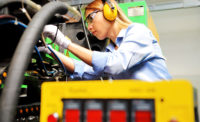Machine guarding once again made OSHA’s top ten list of most-frequently violated standards for fiscal year 2019. Coming in at number eight, OSHA’s machine guarding standard 1910.212 was cited for violations 1,743 times in 2019, compared to 1,972 citations in 2018.
Total penalties in 2019 equaled $11,335,996. $11 million may not seem like much when you consider that in 2015 there were 2,644 amputations, according to the Bureau of Labor Statistics. Between 1992 and 1999, there was an average of more than 11,000 amputations every year. Many times, the loss of a finger, hand or arm results from machinery operations, and often the lack of proper guarding, or inadequate guarding.
Hazardous industries
Amputations, often resulting from the absence or misuse of machine guarding, are most like to occur in these industries, according to OSHA:
- Food manufacturing
- Animal slaughtering
- Meat processing
- Poultry processing
- Bakeries
- Sawmills
- Wood window and doors manufacturing
- Box manufacturing
- Printing operations
- Various machinery and equipment manufacturing
Sources of amputations
According to OSHA, the most common sources of amputations are:
- Agricultural, garden machinery, bailers
- Aerial list platforms
- Benders, rollers and shapers,
- Casting machinery
- Conveyors
- Stationary drills
- Food and beverage processing
- Grinders, abraders and meat grinders
- Material machinery
- Metal, woodworking and special material machinery
- Milling machines
In addition to potentially life-altering amputations, the lack, inadequacy or misuse of machine guards can result in lacerations, crushing injuries and abrasions. Inadequate machine guarding results in approximately 800 deaths every year.
Types of safeguards
There are five general types of machine safeguards:
Guards – these are physical barriers that prevent contact. They can be fixed, interlocked, adjustable, or self-adjusting.
Devices – these limit or prevent access to the hazardous area. These can be presence-sensing devices, pullback or restraint straps, safety trip controls, two-hand controls, or gates.
Automated Feeding and Ejection Mechanisms – These eliminate the operator’s exposure to the point of operation while handling stock (materials).
Machine Location or Distance – this method removes the hazard from the operator’s work area.
Miscellaneous Aids – these methods can be used to protect both operators and people in the immediate vicinity of operating machinery. Examples include shields to contain chips, sparks, sprays or other forms of flying debris; holding tools that an operator can use to handle materials going into the point of operation; and awareness barriers to warn people about hazards in the area.
Machinery hazards
The three basic types of hazardous mechanical motions and actions are:
Hazardous Motions – including rotating machine parts, reciprocating motions (sliding parts or up/down motions), and transverse motions (materials moving in a continuous line);
Points of Operation – the areas where the machine cuts, shapes, bores, or bends the stock being fed through it;
Pinch Points and Shear Points – the area where a part of the body or clothing could be caught between a moving part and a stationary object. This would include power transmission apparatuses such as flywheels, pulleys, belts, chains, couplings, spindles, cams, gears, connecting rods and other machine components that transmit energy.
Compliance
To be in compliance with California OSHA machine guarding standards, similar to federal OSHA’s, all guards must:
Prevent contact – machine guards must provide a physical barrier that prevents the operator from having any part of his/her body in the “danger zone” during the machine’s operating cycle;
Be secured in place or otherwise be tamper proof – machine guards must be secure and strong so that workers are not able to bypass, remove, or tamper with them. They must be attached to the machine where possible. If the guard cannot be physically attached to the machine it must be attached elsewhere;
Create no new hazard – A safeguard defeats its own purpose if it creates a hazard of its own such as a shear point, a jagged edge, or an unfinished surface which can cause a laceration. The edges of guards, for instance, should be rolled or bolted in such a way that they eliminate sharp edges. Machine guards should not obstruct the operator’s view;
Allow for lubrication with the guard still in place - If possible, you should be able to lubricate the machine without removing safeguards. Locating oil reservoirs outside the guard, with a line leading to the lubrication point, will reduce the need for the operator or maintenance worker to enter the hazardous area.
Not interfere with the machine operation - Any safeguard which impedes a worker from performing the job quickly and comfortably might soon be overridden or disregarded. Proper safeguarding can actually enhance efficiency since it can relieve the worker’s apprehensions about injury.
OSHA recommends machine guards:
- Should be appropriate for the hazards employees are trying to avoid.
- Should be maintained in good condition.
- Should be stored when not in use so that it is not damaged or lost.
- Should be kept clean and fully functional.
Mistakes continue
Why? Here are five reasons you should be aware of:
- Assuming new machinery meets machine guarding safety standards
- Removing guards or failing to replace machine guards after their removal for maintenance
- Using inadequate materials when installing or replacing machine guard parts
- Not updating machine guarding safety practices to meet the needs created by new technology
- Insufficient machine guard training




